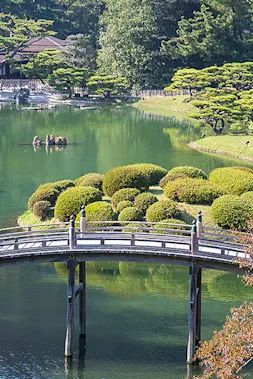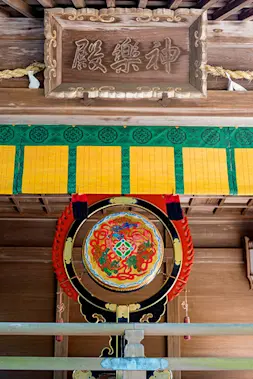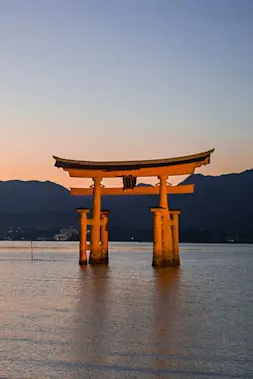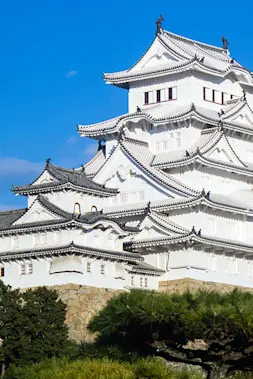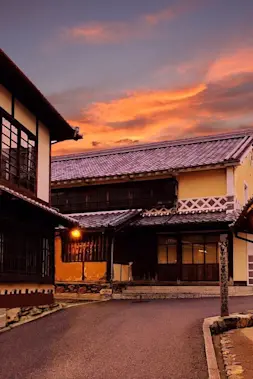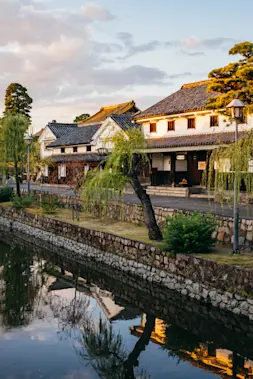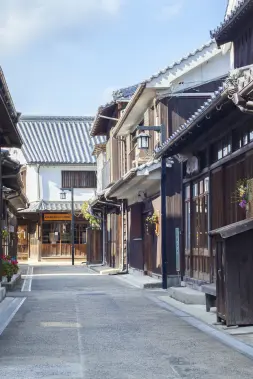History
Motonosumi Shrine - A Gateway Fit for a God

-
- DESTINATION NAME
- Yamaguchi
-
- RELATED TAGS
-
- LAST UPDATED
- 24 September, 2021
Driving through the early morning darkness along a coastal highway, the road and surrounding woods seem alive with wildlife. Following a slow, sharp turn on the narrow road, I was suddenly confronted by a huge wild boar standing center stage and dazed by my headlights. All the while, strong winds whistle through the branches beside the road as the hog and I stare at each other. The darkness hides everything but the animal before me, and I feel like I’m deep in the wilderness. In reality though, I am just moments away from the famous red gates of the Motonosumi Inari Shrine in Nagato, Yamaguchi Prefecture.
After an incredibly windy drive, I’m relieved and a bit excited to arrive, but also a little disappointed to find a taxi already in the parking lot – even though I had woken before the crack of dawn, I was still not the first visitor to arrive today. A group of tourists from abroad are already on site taking photos. Well, I may not be the first, but I will be the most adventurous – for what that’s worth.
The bright red gates leading down to the ocean are a spectacular sight, and the surrounding nature only works to intensify the beauty. Looking out, the watery world seems endless, with only ocean, clouds, and sky punctuating the vista beyond the shrine.
As the super-early risers stay up top to savor the view over the red gates, I decide to walk to the bottom. It is raining. It’s raining, and at first I don’t notice there are no steps, just a steep concrete slope, and a slippery one to boot – not good. Edging down, in the blink of an eye I find myself grasping at the nearest thing for support. Luckily, there are 123 bright red gates, easy to see and one within reach every step of the way.
My advice? Go very slowly down the slope. Not carrying a camera attached to a tripod could also be a useful rule of thumb for rainy days.
Once down the slope, I have access to a whole new world. From the grassy outcrop to the left, which overlooks a craggy cliff facing the ocean, I notice the feathered folk are stirring. Powerful birds of prey are taking off from protected perches below as the swell crashes against the rocks below. Sea, land, and air seem somehow more interconnected here watching these winged predators take off and fly out over the ocean. As a matter fact, the abundant nature is also the reason why this site exists at all.
Legend has it that a fisherman who had become wealthy from the ocean’s bounty was visited by a white fox, a shinto spirit named Inari, claiming credit for his success. It seemed only appropriate to honor such a generous benefactor. While the temple has existed since 1955, it apparently wasn’t enough. Starting in 1987, and currently consisting of 123 red gates, this path of devotion was created by the fortunate fisherman as a tribute to the mysterious fox.
The gate at the top of the small shrine complex holds a devotional box for donations at its apex. Some think of it as a wishing box – get your coin in the box, and it said your wish will be granted. Tempting proposition, but making the 5 meter throw to the top of the gate is no easy task. After exhausting my meagre supply of “lucky” 5 yen coins, I give up, concluding I was fortunate enough to be here, and could ask for no more.
Passing through the final gate on the promontory I turn my back on the sea and take in the view. Only then do I realize that I’m actually standing at the entrance, not the exit. Well of course! If it is a shrine dedicated to the mystery fox who takes credit for providing the sea’s bounty, it is only natural to assume the fox would approach from the ocean.
Ah, bounty of the sea. I remind myself that I should probably head off in search of my own reward for the early morning – a generous breakfast. Maybe fish?
Photographs & Text by Julian Littler
RELATED DESTINATION
Yamaguchi
Yamaguchi is surrounded by ocean, mountains and rivers and is characterized by its climate, which is comfortable throughout the year. Its natural scenery, which includes some 1,500 kilometers of coastline, is a cut above. The prefecture has Kintaikyo Bridge, one of the three most famous bridges in Japan, and other tourist attractions, and its fugu (pufferfish) is famous as a winter dish.































